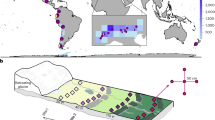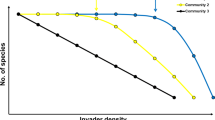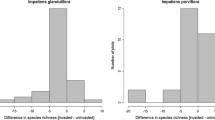Abstract
Identifying declining species is essential for conservation planning. This research assessed abundance and distribution changes of 207 plant species in north-central North America and evaluated the importance of a suite of functional characteristics in predicting their persistence over 115 years (1895–2009). Functional characteristics included native versus introduced origin, pollination syndrome, symbiosis and habitat requirements, and phenological responsiveness to temperature change. Plant specimens from Ohio State University’s Herbarium were used to assess abundance and distribution changes. The partial Solow equation and the sighting rate model were used to calculate the average probability that a species had declined over the study interval. Rarefaction analysis was used to calculate the percent change in distribution as measured by county occurrences from historic (1895–1970) to modern (1971–2009) time periods. Twenty-seven percent of the 207 species decreased in abundance from 1895 to 2009 and 68 % showed distribution contraction. Native species were seven times more likely to decline in abundance and showed a two-fold greater distribution contraction compared to introduced species. Introduced species that strongly advanced flowering with warming showed greater distribution expansion than those with weak phenological responsiveness. Species that require a symbiont for growth or development were twice as likely to decrease in abundance as those without symbiont requirements. This analysis indicates non-random patterns of threat to species diversity among plant functional groups. With climate warming, highly responsive introduced species may become more widespread. Thus, climate warming may exacerbate the already substantial impacts of land-use change, symbiont loss, and non-native species invasion on species persistence.





Similar content being viewed by others
References
Abu-Asab MS, Peterson PM, Shetler SG, Orli SS (2001) Earlier plant flowering in spring as a response to global warming in the Washington, DC, area. Biodivers Conserv 10:597–612. doi:10.1023/a:1016667125469
Akmentins MS, Pereyra LC, Vaira M (2012) Using sighting records to infer extinction in three endemic Argentinean marsupial frogs. Anim Conserv 15:142–151. doi:10.1111/j.1469-1795.2011.00494.x
Arnolds E (1991) Decline of ectomycorrhizal fungi in Europe. Agric Ecosyst Environ 35:209–244. doi:10.1016/0167-8809(91)90052-y
Bates D, Maechler M, Bolker B (2012) lme4: linear mixed-effects models using S4 classes, R package version 0.999999-0. http://www.CRANR-projectorg/package=lme4. Accessed 4 April 2014
Biesmeijer JC et al (2006) Parallel declines in pollinators and insect-pollinated plants in Britain and the Netherlands. Science 313:351–354. doi:10.1126/science.1127863
Burgman MA, Grimson RC, Ferson S (1995) Inferring threat from scientific collections. Conserv Biol 9:923–928. doi:10.1046/j.1523-1739.1995.09040923.x
Cadotte MW, Lovett-Doust J (2002) Ecological and taxonomic differences between rare and common plants of southwestern Ontario. Ecoscience 9:397–406
Calinger KM, Queenborough S, Curtis PS (2013) Herbarium specimens reveal the footprint of climate change on flowering trends across north-central North America. Ecol Lett 16:1037–1044. doi:10.1111/ele.12135
CaraDonna PJ, Iler AM, Inouye DW (2014) Shifts in flowering phenology reshape a subalpine plant community. Proc Natl Acad Sci USA 111:4916–4921. doi:10.1073/pnas.1323073111
Carpaneto GM, Mazziotta A, Valerio L (2007) Inferring species decline from collection records: roller dung beetles in Italy (Coleoptera, Scarabaeidae). Divers Distrib 13:903–919. doi:10.1111/j.1472-4642.2007.00397.x
Cleland EE et al (2012) Phenological tracking enables positive species responses to climate change. Ecology 93:1765–1771
Comita LS, Thompson J, Uriarte M, Jonckheere I, Canham CD, Zimmerman JK (2010) Interactive effects of land use history and natural disturbance on seedling dynamics in a subtropical forest. Ecol Appl 20:1270–1284. doi:10.1890/09-1350.1
Dahl TE (1990) Wetlands losses in the United States 1780s to 1980s (Version 16 July 1997). US Department of the Interior, Fish and Wildlife Service, Washington, DC; Northern Prairie Wildlife Research Center Online, Jamestown. http://www.npwrcusgsgov/resource/wetlands/wetloss/indexhtm
Dahl T, Allord GJ (1996) Technical aspects of wetlands. History of wetlands in the conterminous United States. National water summary: wetland resources, Vol 2425. U.S. Geological Survey Water Supply Paper, pp 19–26
DeVries PJ, Murray D, Lande R (1997) Species diversity in vertical, horizontal, and temporal dimensions of a fruit-feeding butterfly community in an Ecuadorian rainforest. Biol J Linn Soc 62:343–364. doi:10.1111/j.1095-8312.1997.tb01630.x
Duffy KJ, Kingston NE, Sayers BA, Roberts DL, Stout JC (2009) Inferring national and regional declines of rare orchid species with probabilistic models. Conserv Biol 23:184–195. doi:10.1111/j.1523-1739.2008.01064.x
Farnsworth EJ, Ogurcak DE (2006) Biogeography and decline of rare plants in New England: historical evidence and contemporary monitoring. Ecol Appl 16:1327–1337. doi:10.1890/1051-0761(2006)016[1327:badorp]2.0.co;2
Farnsworth EJ, Ogurcak DE (2008) Functional groups of rare plants differ in levels of imperilment. Am J Bot 95:943–953. doi:10.3732/ajb.0800013
Fitter AH, Fitter RSR (2002) Rapid changes in flowering time in British plants. Science 296:1689–1691. doi:10.1126/science.1071617
Freckleton RP, Harvey PH, Pagel M (2002) Phylogenetic analysis and comparative data: a test and review of evidence. Am Nat 160:712–726. doi:10.1086/343873
Gerlach JD, Rice KJ (2003) Testing life history correlates of invasiveness using congeneric plant species. Ecol Appl 13:167–179. doi:10.1890/1051-0761(2003)013[0167:tlhcoi]2.0.co;2
Gotelli NJ, Colwell RK (2001) Quantifying biodiversity: procedures and pitfalls in the measurement and comparison of species richness. Ecol Lett 4:379–391. doi:10.1046/j.1461-0248.2001.00230.x
Hamer AJ, McDonnell MJ (2010) The response of herpetofauna to urbanization: inferring patterns of persistence from wildlife databases. Austral Ecol 35:568–580. doi:10.1111/j.1442-9993.2009.02068.x
Heck KL, Vanbelle G, Simberloff D (1975) Explicit calculation of rarefaction diversity measurement and determination of sufficient sample size. Ecology 56:1459–1461. doi:10.2307/1934716
Honnay O, Jacquemyn H, Bossuyt B, Hermy M (2005) Forest fragmentation effects on patch occupancy and population viability of herbaceous plant species. New Phytol 166:723–736. doi:10.1111/j.1469-8137.2005.01352.x
Hulme PE (2011) Contrasting impacts of climate-driven flowering phenology on changes in alien and native plant species distributions. New phytol 189:272–281. doi:10.1111/j.1469-8137.2010.03446.x
Iler AM, Hoye TT, Inouye DW, Schmidt NM (2013a) Nonlinear flowering responses to climate: are species approaching their limits of phenological change? Philos Trans R Soc B. doi:10.1098/rstb.2012.0489
Iler AM, Inouye DW, Hoye TT, Miller-Rushing AJ, Burkle LA, Johnston EB (2013b) Maintenance of temporal synchrony between syrphid flies and floral resources despite differential phenological responses to climate. Glob Change Biol 19:2348–2359. doi:10.1111/gcb.12246
Inouye DW (2008) Effects of climate change on phenology, frost damage, and floral abundance of montane wildflowers. Ecology 89:353–362. doi:10.1890/06-2128.1
Lichvar RW (2013) The national wetland plant list: 2013 wetland ratings. Phytoneuron 2013:1–241
Luiz OJ, Edwards AJ (2011) Extinction of a shark population in the Archipelago of Saint Paul’s Rocks (equatorial Atlantic) inferred from the historical record. Biol Conserv 144:2873–2881. doi:10.1016/j.biocon.2011.08.004
McCarthy MA (1998) Identifying declining and threatened species with museum data. Biol Conserv 83:9–17. doi:10.1016/s0006-3207(97)00048-7
McCormick MK, Whigham DF, O’Neill J (2004) Mycorrhizal diversity in photosynthetic terrestrial orchids. New Phytol 163:425–438. doi:10.1111/j.1469-8137.2004.01114.x
McInerny GJ, Roberts DL, Davy AJ, Cribb PJ (2006) Significance of sighting rate in inferring extinction and threat. Conserv Biol 20:562–567. doi:10.1111/j.1523-1739.2006.00377.x
Medley KE, Okey BW, Barrett GW, Lucas MF, Renwick WH (1995) Landscape change with agricultural intensification in a rural watershet, southwestern Ohio, USA. Landsc Ecol 10:161–176. doi:10.1007/bf00133029
Menne MJ, Williams CN Jr, Vose RS (2010) United States historical climatology network (USHCN) version 2 serial monthly dataset. Carbon Dioxide Information Analysis Center, Oak Ridge National Laboratory, Oak Ridge
Menzel A et al (2006) European phenological response to climate change matches the warming pattern. Glob Change Biol 12:1969–1976. doi:10.1111/j.1365-2486.2006.01193.x
Newbold T (2010) Applications and limitations of museum data for conservation and ecology, with particular attention to species distribution models. Prog Phys Geogr 34:3–22. doi:10.1177/0309133309355630
Oksanen J, Blanchet FG, Kindt R, Legendre P, Minchin PR, O'Hara RB, Simpson GL, Solymos P, Stevens MHH, Wagner H (2013) Vegan: community ecology package. R package version 2.0-10
Orme D, Freckleton R, Thomas G, Petzoldt T, Fritz S, Isaac N, Pearse W (2012) Caper: comparative analyses of phylogenetics and evolution in R. R package version 0.5
Pagel M (1999) Inferring the historical patterns of biological evolution. Nature 401:877–884. doi:10.1038/44766
Parmesan C, Yohe G (2003) A globally coherent fingerprint of climate change impacts across natural systems. Nature 421:37–42. doi:10.1038/nature01286
Pearson DE, Ortega YK, Sears SJ (2012) Darwin’s naturalization hypothesis up-close: intermountain grassland invaders differ morphologically and phenologically from native community dominants. Biol Invasions 14:901–913. doi:10.1007/s10530-011-0126-4
Ponder WF, Carter GA, Flemons P, Chapman RR (2001) Evaluation of museum collection data for use in biodiversity assessment. Conserv Biol 15:648–657. doi:10.1046/j.1523-1739.2001.015003648.x
Prasad AM, Iverson LR, Matthews S, Peters M (2007) A climate change atlas for 134 forest tree species of the eastern United States (database)
R Development Core Team (2008) R: a language and environment for statistical computing. R Foundation for Statistical Computing, Vienna
Rasmussen HN, Whigham DF (2002) Phenology of roots and mycorrhiza in orchid species differing in phototrophic strategy. New Phytol 154:797–807. doi:10.1046/j.1469-8137.2002.00422.x
Revell LJ, Harmon LJ, Collar DC (2008) Phylogenetic signal, evolutionary process, and rate. Syst Biol 57:591–601. doi:10.1080/10635150802302427
Rivadeneira MM, Hunt G, Roy K (2009) The use of sighting records to infer species extinctions: an evaluation of different methods. Ecology 90:1291–1300. doi:10.1890/08-0316.1
Rosenzweig C et al (2008) Attributing physical and biological impacts to anthropogenic climate change. Nature 453:353–357. doi:10.1038/nature06937
Sherry RA et al (2007) Divergence of reproductive phenology under climate warming. Proc Natl Acad Sci USA 104:198–202. doi:10.1073/pnas.0605642104
Solow AR (1993) Inferring extinction in a declining population. J Math Biol 32:79–82. doi:10.1007/bf00160376
Solow AR, Roberts DL (2003) A nonparametric test for extinction based on a sighting record. Ecology 84:1329–1332. doi:10.1890/0012-9658(2003)084[1329:antfeb]2.0.co;2
Solow AR, Roberts DL (2006) Museum collections, species distributions, and rarefaction. Divers Distrib 12:423–424. doi:10.1111/j.1366-9516.2006.00259.x
Stevens PF (2004) Angiosperm phylogeny website. http://www.mobotorg/MOBOT/research/APweb/. Accessed 01 Aug 2013
Thomson JD (2010) Flowering phenology, fruiting success and progressive deterioration of pollination in an early-flowering geophyte. Philos Trans R Soc B Biol Sci 365:3187–3199. doi:10.1098/rstb.2010.0115
Traveset A, Richardson DM (2006) Biological invasions as disruptors of plant reproductive mutualisms. Trends Ecol Evol 21:208–216. doi:10.1016/j.tree.2006.01.006
Ungricht S, Rasplus JY, Kjellberg F (2005) Extinction threat evaluation of endemic fig trees of New Caledonia: priority assessment for taxonomy and conservation with herbarium collections. Biodivers Conserv 14:205–232. doi:10.1007/s10531-005-5049-x
van der Ree R, McCarthy MA (2005) Inferring persistence of indigenous mammals in response to urbanisation. Anim Conserv 8:309–319. doi:10.1017/s1367943005002258
Vogelsang KM, Bever JD (2009) Mycorrhizal densities decline in association with nonnative plants and contribute to plant invasion. Ecology 90:399–407. doi:10.1890/07-2144.1
Webb CO, Donoghue MJ (2005) Phylomatic: tree assembly for applied phylogenetics. Mol Ecol Notes 5:181–183. doi:10.1111/j.1471-8286.2004.00829.x
Willis CG, Ruhfel B, Primack RB, Miller-Rushing AJ, Davis CC (2008) Phylogenetic patterns of species loss in Thoreau’s woods are driven by climate change. Proc Natl Acad Sci USA 105:17029–17033. doi:10.1073/pnas.0806446105
Willis CG, Ruhfel BR, Primack RB, Miller-Rushing AJ, Losos JB, Davis CC (2010) Favorable climate change response explains non-native species’ success in Thoreau’s woods. PLoS One 5:e8878. doi:10.1371/journal.pone.0008878
Wolkovich EM, Cleland EE (2011) The phenology of plant invasions: a community ecology perspective. Front Ecol Environ 9:287–294. doi:10.1890/100033
Wolkovich EM et al (2013) Temperature-dependent shifts in phenology contribute to the success of exotic species with climate change. Am J Bot 100:1407–1421. doi:10.3732/ajb.1200478
Acknowledgments
I thank Peter Curtis and Simon Queenborough for comments on the manuscript. I also thank Amanda Wubben for assistance processing data and Don and Manetta Calinger and Mary Vargo for their constant support and guidance.
Author information
Authors and Affiliations
Corresponding author
Additional information
Communicated by Matts Lindbladh.
Electronic supplementary material
Below is the link to the electronic supplementary material.
Rights and permissions
About this article
Cite this article
Calinger, K.M. A functional group analysis of change in the abundance and distribution of 207 plant species across 115 years in north-central North America. Biodivers Conserv 24, 2439–2457 (2015). https://doi.org/10.1007/s10531-015-0936-2
Received:
Revised:
Accepted:
Published:
Issue Date:
DOI: https://doi.org/10.1007/s10531-015-0936-2




